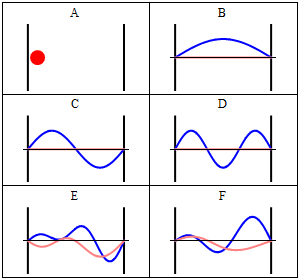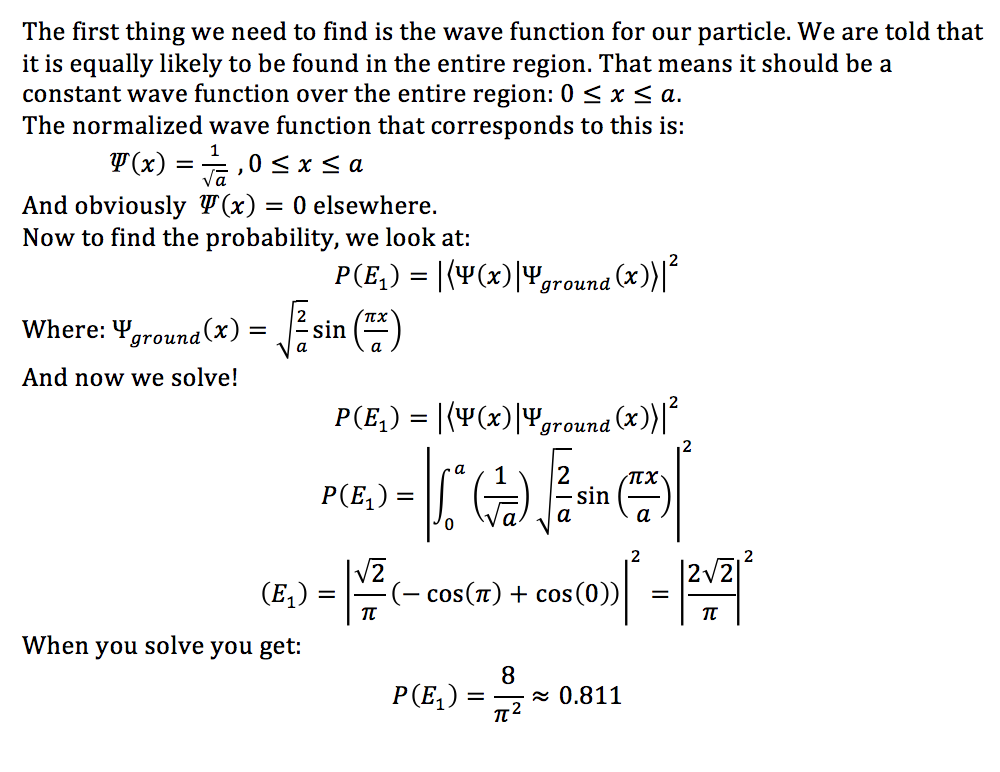Infinite Square Well
 A particle of mass
m
is in an infinite square well of width
a
. The particle is equally likely to be found in the region. What is the probability that a measurement of energy is found at ground state?
A particle of mass
m
is in an infinite square well of width
a
. The particle is equally likely to be found in the region. What is the probability that a measurement of energy is found at ground state?
The answer is 0.8106.
This section requires Javascript.
You are seeing this because something didn't load right. We suggest you, (a) try
refreshing the page, (b) enabling javascript if it is disabled on your browser and,
finally, (c)
loading the
non-javascript version of this page
. We're sorry about the hassle.
2 solutions
Let the position space wavefunction describing this system be given by Ψ ( x , t ) . We know that we can write the wavefunction as a linear combination of energy eigenfunctions:
Ψ ( x , t ) = n ∑ c n ( t ) ψ n ( x )
Now, we will have H ^ ψ n ( x ) = E n ψ n ( x ) . We also know that by the Schrödinger equation we will have:
i ℏ d t d Ψ = H ^ Ψ ⇒ i ℏ n ∑ d t d c n ( t ) ψ n ( x ) = n ∑ c n ( t ) E n ψ n ( x )
As each energy eigenfunction is orthonormal, we solve the general differential equation by matching up terms in the sums, getting c n ( t ) = c n ( 0 ) e − i E n t / ℏ . By Born's rules, we know that the probability of finding the particle in the n -th energy eigenstate is given by:
∣ c n ( t ) ∣ 2 = ∣ c n ( 0 ) e − i E n t / ℏ ∣ 2 = ∣ c n ( 0 ) ∣ 2
We know that at some time t 0 , the particle is equally likely to be found anywhere in the well. Thus, we will have Ψ ( x , t 0 ) = C , where C is some constant. We also know that:
Ψ ( x , t 0 ) = n ∑ c n ( 0 ) e − i E n t 0 / ℏ ψ n ( x )
Thus, since each ψ n ( x ) is orthonormal, multiplying by ψ i ∗ ( x ) and integrating will cancel all terms except for the i -th, where the integral of the eigenstate multiplied by its conjugate will be 1 , leaving c n ( 0 ) e − i E n t 0 / ℏ , where we multiply by its conjugate to get the final probability ∣ c n ( 0 ) ∣ 2 (the exponential cancels with its conjugate). Thus, we have:
c 1 ( 0 ) e − i E 1 t 0 / ℏ = ∫ 0 a Ψ ( x , t 0 ) ψ 1 ∗ ( x ) d x
By the normalization condition, we can find C :
∫ 0 a ∣ Ψ ( t 0 , x ) ∣ 2 d x = ∫ 0 a ∣ C ∣ 2 d x = 1 ⇒ C = a 1
Now, all that's left to do is to solve the time-independent Schrödinger equation to get ψ 1 ∗ ( x ) . I'm not going to go through this, but we end up getting:
ψ n ( x ) = a 2 sin ( a n π x )
Thus, we get:
c 1 ( 0 ) e − i E 1 t 0 / ℏ = ∫ 0 a a 1 a 2 sin ( a π x ) d x = π 2 2
Thus, we have:
∣ c 1 ( 0 ) = π 2 8 ≈ 0 . 8 1 0 5 6 9 4 6 9 1 3
